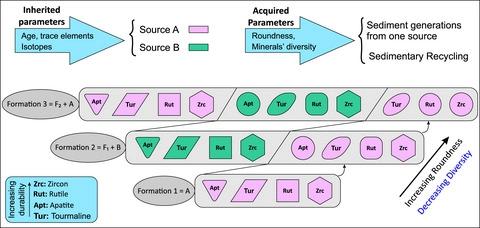当前位置:
X-MOL 学术
›
Basin Res.
›
论文详情
Our official English website, www.x-mol.net, welcomes your feedback! (Note: you will need to create a separate account there.)
Evaluating sediment recycling through combining inherited petrogenic and acquired sedimentary features of multiple detrital minerals
Basin Research ( IF 3.2 ) Pub Date : 2021-12-25 , DOI: 10.1111/bre.12650 Yousef Zoleikhaei 1 , Jacob A. Mulder 1, 2 , Peter A. Cawood 1
Basin Research ( IF 3.2 ) Pub Date : 2021-12-25 , DOI: 10.1111/bre.12650 Yousef Zoleikhaei 1 , Jacob A. Mulder 1, 2 , Peter A. Cawood 1
Affiliation

|
An implicit assumption of most sedimentary provenance analyses is a direct link between source and sink. However, recycling of sedimentary detritus from pre-existing strata interrupts the direct source-to-sink link and can result in incorrect interpretations of paleogeography and paleodrainage. Detrital zircon is the favoured proxy of contemporary provenance studies, but its physiochemical resilience makes it particularly prone to recycling. In this study, we integrate geochemical (age, isotope, and trace elements) and grain roundness data of multiple detrital minerals with different physiochemical stabilities (zircon, tourmaline, rutile, and apatite) to evaluate the importance of recycling in an ancient sedimentary basin. We focus on the early Cambrian Lalun Formation of Iran, which forms part of a laterally extensive sandstone-rich succession deposited along the northern margin of Gondwana. The Lalun Formation preserves a distinct change of compositional maturity between lower arkose and shale units and an upper unit of quartz-rich sandstone. Detrital zircon, rutile, and apatite data demonstrate that all units of the Lalun Formation share a common source in the Arabian-Nubian Shield. Whole-rock geochemical data further indicate that all units have similar chemical alteration indices, suggesting the change in compositional maturity is not a product of differential weathering of the source region. Analysis of grain roundness reveals that detrital zircon, rutile, and tourmaline in the upper quartz-rich unit are typically more rounded than those in the underlying arkose and shale units. In contrast, detrital apatite grains are nearly all angular in the quartz-rich unit but mostly rounded in the lower arkose and shale. Together, the detrital mineral provenance, whole-rock geochemistry, and morphological data are consistent with recycling of the lower arkose and shale units of the Lalun Formation into the uppermost quartz-rich unit, with the latter also receiving a component of first-cycle detritus represented by angular detrital apatite. Our findings demonstrate that integrating the features of detrital minerals acquired during a sedimentary cycle (grain rounding and diversity of mineral assemblages) with features inherited from their ultimate source rocks (age, isotopic, and geochemical proxies) can assist in recognising sediment recycling in ancient strata.
中文翻译:

通过结合多种碎屑矿物的继承成岩和后天沉积特征评价沉积物循环利用
大多数沉积物源分析的隐含假设是源和汇之间的直接联系。然而,从预先存在的地层中回收沉积碎屑会中断直接的源-汇连接,并可能导致对古地理和古排水的错误解释。碎屑锆石是当代来源研究的首选代表,但其物理化学弹性使其特别容易回收。在这项研究中,我们整合了多种具有不同物理化学稳定性的碎屑矿物(锆石、电气石、金红石和磷灰石)的地球化学(年龄、同位素和微量元素)和颗粒圆度数据,以评估循环在古代沉积盆地中的重要性。我们专注于伊朗早期寒武纪拉伦组,它构成沿冈瓦纳北部边缘沉积的横向广泛的富含砂岩的层序的一部分。Lalun 组在下层长石和页岩单元与上层富含石英砂岩单元之间保留了明显的成分成熟度变化。碎屑锆石、金红石和磷灰石数据表明,Lalun 组的所有单元在阿拉伯-努比亚地盾中有一个共同的来源。全岩地球化学数据进一步表明所有单元具有相似的化学蚀变指数,表明成分成熟度的变化不是源区差异风化的产物。颗粒圆度分析表明,上部富石英单元中的碎屑锆石、金红石和电气石通常比下伏长石和页岩单元中的更圆。相比之下,碎屑磷灰石颗粒在富含石英的单元中几乎都是有角的,但在下层长石和页岩中大多是圆形的。总之,碎屑矿物来源、全岩地球化学和形态数据与拉伦组下部长石和页岩单元再循环到最上部富石英单元一致,后者也接收到第一旋回碎屑的成分以角碎屑磷灰石为代表。我们的研究结果表明,将沉积循环中获得的碎屑矿物的特征(颗粒圆化和矿物组合的多样性)与其最终烃源岩继承的特征(年龄、同位素和地球化学代理)相结合,有助于识别古代地层中的沉积物循环.
更新日期:2021-12-25
中文翻译:

通过结合多种碎屑矿物的继承成岩和后天沉积特征评价沉积物循环利用
大多数沉积物源分析的隐含假设是源和汇之间的直接联系。然而,从预先存在的地层中回收沉积碎屑会中断直接的源-汇连接,并可能导致对古地理和古排水的错误解释。碎屑锆石是当代来源研究的首选代表,但其物理化学弹性使其特别容易回收。在这项研究中,我们整合了多种具有不同物理化学稳定性的碎屑矿物(锆石、电气石、金红石和磷灰石)的地球化学(年龄、同位素和微量元素)和颗粒圆度数据,以评估循环在古代沉积盆地中的重要性。我们专注于伊朗早期寒武纪拉伦组,它构成沿冈瓦纳北部边缘沉积的横向广泛的富含砂岩的层序的一部分。Lalun 组在下层长石和页岩单元与上层富含石英砂岩单元之间保留了明显的成分成熟度变化。碎屑锆石、金红石和磷灰石数据表明,Lalun 组的所有单元在阿拉伯-努比亚地盾中有一个共同的来源。全岩地球化学数据进一步表明所有单元具有相似的化学蚀变指数,表明成分成熟度的变化不是源区差异风化的产物。颗粒圆度分析表明,上部富石英单元中的碎屑锆石、金红石和电气石通常比下伏长石和页岩单元中的更圆。相比之下,碎屑磷灰石颗粒在富含石英的单元中几乎都是有角的,但在下层长石和页岩中大多是圆形的。总之,碎屑矿物来源、全岩地球化学和形态数据与拉伦组下部长石和页岩单元再循环到最上部富石英单元一致,后者也接收到第一旋回碎屑的成分以角碎屑磷灰石为代表。我们的研究结果表明,将沉积循环中获得的碎屑矿物的特征(颗粒圆化和矿物组合的多样性)与其最终烃源岩继承的特征(年龄、同位素和地球化学代理)相结合,有助于识别古代地层中的沉积物循环.



























 京公网安备 11010802027423号
京公网安备 11010802027423号